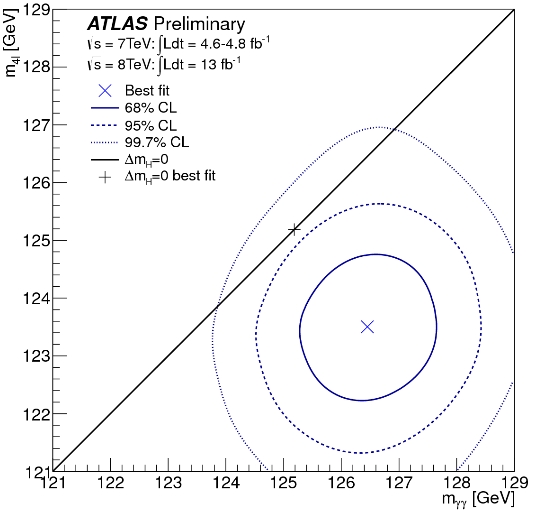The Higgs boson signals found by the experiments were strong and coherent enough to convince physicists as well as the general public, but at the same time the few small inconsistencies unavoidably present in any data sample, driven by statistical fluctuations, were a stimulus for fantasy interpretations. Supersymmetry enthusiasts, in particular, saw the 125 GeV boson as the first found of a set of five. SUSY in fact requires the presence of at least five such states.
Maybe the most intriguing anomaly among the set of ATLAS and CMS results were the "twin peaks" of ATLAS. That collaboration measured a different Higgs boson mass in H->diphoton and in H->four lepton final states. In the graph below you can see one-sigma contours in the plane spanned by the two mass measurements: the center of the measurement ellipses appears incompatible with the diagonal line (which of course describes the hypothesis that what is measured is the same parameter on the x and y axis), although statistically the effect is a disagreement at the level of 1% or so, hence not terribly odd. A detailed discussion of the effect is offered in this blog post I wrote in 2012. (and I came back on the same topic two years afterwards).

When the discussion arose on whether this could be taken as a first indication that what had been found by the LHC experiments were in fact two higgs bosons states of very similar mass, I was quick to offer a bet of $100 on the matter. This was taken by Jeffrey Lea, a reader of this blog, who sincerely hoped that indeed the Higgs discovery would prove to be the start of a journey into many more discoveries... A hope I did share, but maybe with less faith.
Four years later, with 2015 and 2016 data, the matter has been resolved for good: the larger statistics and the improved calibrations allow ATLAS to measure more compatible masses in the two final states. Jeff has therefore graciously conceded the bet, and he sent me the text below, which I am happy to paste here.
My Dear Tommaso,
It is with pleasure (but per our discussions, mutually shared and understandable regret), that I write to concede our December 2012 bet… "If, by analyzing larger datasets, either the ATLAS or the CMS experiments will claim strong evidence or discovery (larger than four standard deviations) for two distinct resonances in the 120-130 GeV region in their searches for Higgs-like particles before July 1st, 2017."
In concession, I am enclosing a $100 U.S. bill in recognition that neither CERN experiments have (as yet!) discovered 2 or more Higgs-like particles. To paraphrase the English geneticist John Burden Sanderson Haldane and physicist William H. George, I firmly believe the universe is not only queerer than we together suppose, but queerer than we cansuppose... that that there indeed more things in heaven and earth that are dreamed of, or can be dreamed of.
You and the scientific teams of CERN are actively dealing with a living, growing thing.Your task will never be done. I sincerely wish you and the CERN teams great and continued success in your endeavors to expand mankind’s fundamental understanding of our universe!
Sincerely, Jeffrey A. Lea
So I am $100 richer now, although I would have indeed much preferred to be poorer but more excited about particle physics... But who knows, maybe a new discovery awaits us with the very large datasets that ATLAS and CMS have been collecting this year. For you should know that the LHC has been working wonders, and collected already more data this year than it did in all previous years combined. So, stay tuned!




Comments